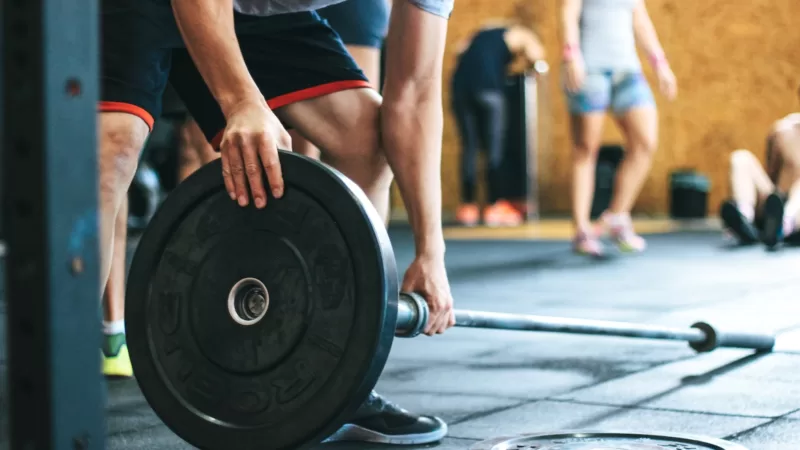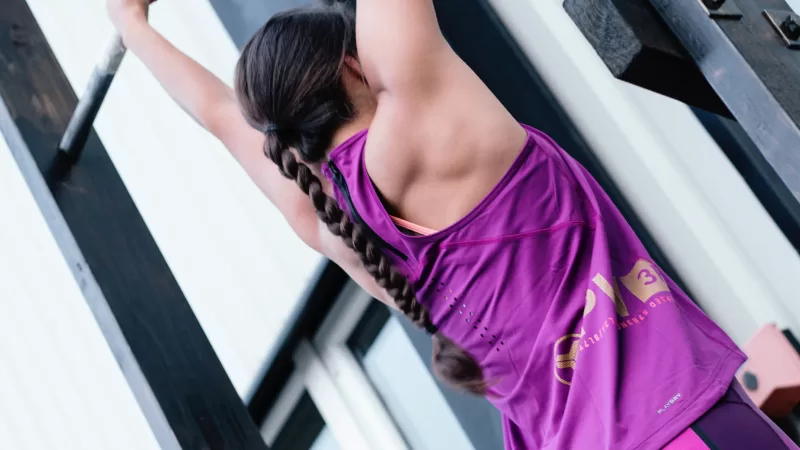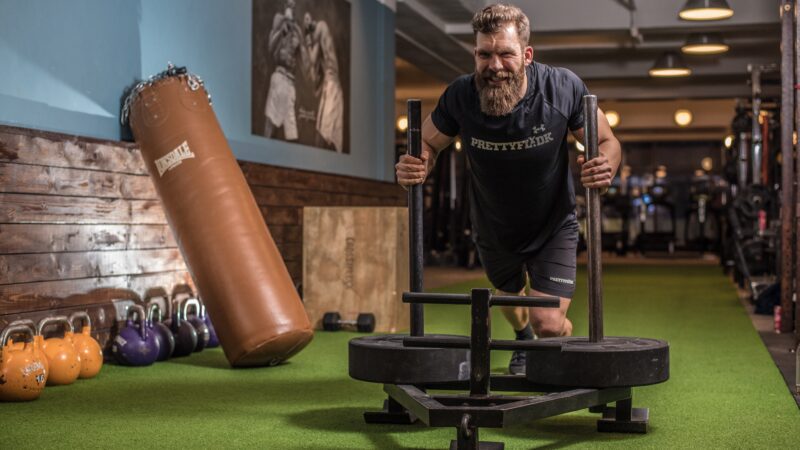Master CrossFit Terminology: The Ultimate Glossary

CrossFit is a popular high-intensity fitness program that has gained a massive following worldwide. However, for beginners, the terminology used in CrossFit can be overwhelming and confusing. It’s essential to understand the meaning of key terms and abbreviations used in CrossFit workouts such as front squat, kettlebells, cft, and kipping pullups to get the most out of your training sessions.
CrossFit Boxes often use abbreviations to describe their workout structure, which includes functional movements such as muscle ups and bar pull ups. For instance, AMRAP (as many rounds as possible) and EMOM (every minute on the minute) are two common abbreviations you’ll come across when attending a CrossFit workout that may include exercises like front squats.
The CrossFit Total is another benchmark workout that measures an athlete’s one-rep max for three lifts: squat, deadlift, and press using a barbell. This workout incorporates functional movements such as bar pull ups and kipping pullups. Understanding these terms will help you follow along with your trainer’s instructions during workouts.
In this post, we’ll explore some of the most common Crossfit terminology, including functional movements and bar pull ups. We’ll discuss what these prescribed exercises mean and how they’re used in workouts.
Understanding CrossFit Terminology
It’s essential to understand the meaning behind different Crossfit terminologies if you want to get the best results from your training sessions. Knowing the certification of your coach and the workout structure means you can make the most out of your barbell workouts. Here are some of the most important terms you should know:
- WOD – Workout Of The Day: This refers to the daily exercise routine prescribed by your trainer or gym. For more information and a complete list of CrossFit terms, check out the CrossFit dictionary and CrossFit Journal. Don’t forget to participate in the annual CrossFit Open competition!
- Box – A term used for a Crossfit gym or facility where barbell workouts, squats, and other exercises take place. Many boxes also participate in Crossfit Games and the annual Open competition.
- RX – Refers to performing a CrossFit workout as prescribed without any modifications or scaling down. This is especially important during the CrossFit Open, a competition that tests the fitness of CrossFit athletes from all over the world. For CrossFit beginners, it’s important to find supportive CrossFit boxes where coaches can help modify workouts to fit individual abilities.
- Scaling – Refers to modifying a workout based on an individual’s fitness level or injury status. Squat modifications may be necessary for a CrossFit beginner during the CrossFit Games, which often involve the use of a barbell.
- Chipper – A type of workout that involves completing several exercises back-to-back, usually with high reps. This can include movements such as squats and barbell exercises, and is often seen in CrossFit Games.
- Metcon – Short for metabolic conditioning; this refers to high-intensity cardio-based workouts designed to improve endurance and stamina. The crossfit games often incorporate metcon workouts that involve movements such as squats to start the routine.
- Tabata – A specific type of workout structure consisting of 20 seconds of movement and ten seconds of rest for eight rounds. This type of crossfit games training is great for squats and other exercises.
CrossFit Terminology Explained
- AMRAP – As Many Rounds As Possible: A type of workout popular in CrossFit Games where you perform as many rounds of a set of exercises within a specified time frame, including squats.
- EMOM – Every Minute On the Minute: A type of workout where you complete a specific number of reps of squats within one minute, then rest until the next minute starts. This type of workout is commonly used in CrossFit Games.
- CrossFit Total – A benchmark workout that measures an athlete’s one-rep max for three lifts: squat, deadlift, and press.
Importance of Understanding CrossFit Terminology
Clear communication is essential in any community, and CrossFit is no exception. As a rapidly growing fitness regimen, CrossFit has developed its own unique language and terminology that can be confusing for newcomers. However, understanding CrossFit terminology, including workout structure and squat, is crucial for effective communication within the community.
Following Workouts Accurately
One of the most important benefits of understanding CrossFit terminology is being able to follow workouts accurately, including those that involve squats. Most workouts have specific names like “Fran” or “Murph,” which refer to a particular set of exercises and reps, such as squats. Knowing these terms can help athletes understand what they need to do during a workout, how many reps they should aim for, and how much time they should spend on each exercise, including squats.
For example, if you’re new to CrossFit and someone tells you to do “21-15-9 thrusters and pull-ups,” it might sound like gibberish at first. But once you understand the workout structure, which involves performing 21 thrusters followed by 21 pull-ups, then 15 thrusters followed by 15 pull-ups, and finally 9 thrusters followed by 9 pull-ups, you’ll know exactly what to do.
Preventing Injuries
Another benefit of understanding CrossFit terminology is preventing injuries by ensuring proper form and technique during exercises, especially during squat workouts. Many exercises, such as the snatch and clean and jerk, require careful attention to form in order to avoid injury and fit into the overall workout structure.
For instance, the snatch involves lifting a weighted barbell from the ground overhead in one fluid motion. Without proper form, this exercise can put undue strain on your lower back or shoulders. Understanding the correct technique, along with incorporating squats into your workout structure, can help prevent injury and ensure that you get the most out of each exercise. This is especially important for athletes preparing for crossfit games.
“The Girls” and the New Girls in CrossFit

Benchmark workouts are an essential component of CrossFit training, including squats. They are used to measure progress, set goals, and challenge athletes to push themselves beyond their limits with squats. One of the most popular benchmark workouts in CrossFit is “The Girls,” which includes squats. These workouts are named after women and have become a staple in every CrossFit gym around the world for squats.
Original Girls vs. New Girls
The original girls include Fran, Helen, and Cindy. These workouts are designed to test an athlete’s strength, endurance, and overall fitness level. Fran consists of thrusters and pull-ups with 21-15-9 reps for time. Helen involves running, kettlebell swings, and pull-ups for three rounds. Cindy is a 20-minute AMRAP (as many rounds as possible) of five pull-ups, ten push-ups, and fifteen air squats.
The new girls include Isabel, Grace, and Karen. These workouts were released by CrossFit HQ to keep athletes challenged and motivated. Isabel is a workout consisting of thirty snatches for time with men’s weight at 135lbs while women’s weight at 95lbs; Grace involves thirty clean & jerks for time with men’s weight at 135lbs while women’s weight at 95lbs; Karen is one hundred fifty wall balls for time using a twenty-pound ball for men or fourteen-pound ball for women. Squats are not included in these workouts.
CrossFit HQ releases new Girls periodically based on different movements such as double unders (Annie), tabata intervals (Tabata Something Else), or even burpees (Eva) to provide athletes with new challenges regularly and maintain a dynamic workout structure.
The Importance of Benchmark Workouts
Benchmark workouts like “The Girls” provide athletes with measurable data that can be used to track progress over time. By comparing times or reps from previous attempts, athletes can see how far they’ve come since starting their training journey.
These workouts also create a sense of community within CrossFit gyms. Athletes can cheer each other on, offer support and encouragement, and celebrate each other’s successes. This sense of camaraderie is what makes CrossFit unique and why so many people have fallen in love with the sport.
Exploring Popular CrossFit Workouts: “Murph,” “Fat Amy,” “Grace”
“Murph,” “Fat Amy,” and “Grace”: Exploring Popular CrossFit Workouts
CrossFit is a high-intensity fitness program that incorporates various exercises and movements to improve metabolic conditioning, strength, and endurance. One of the unique aspects of CrossFit is the use of benchmark workouts and hero WODs (Workout of the Day) that challenge athletes both physically and mentally. In this section, we will explore three popular CrossFit workouts: “Murph,” “Fat Amy,” and “Grace.”
“Murph”: A Hero WOD
Named in honor of Navy Lieutenant Michael Murphy, who was killed in Afghanistan in 2005, “Murph” is one of the most challenging hero WODs in CrossFit. The workout includes a one-mile run, 100 pull-ups, 200 push-ups, 300 air squats, and another one-mile run. Athletes can partition the pull-ups, push-ups, and squats as needed but must complete all repetitions before moving on to the next exercise.
Completing “Murph” requires not only physical strength but also mental toughness. The sheer volume of repetitions can be daunting for even the most experienced athletes. However, finishing this workout provides a sense of accomplishment like no other.
“Fat Amy”: A Benchmark Workout
Unlike hero WODs that are named after fallen soldiers or first responders, benchmark workouts serve as standards for measuring an athlete’s progress over time. One such benchmark workout is “Fat Amy.” This workout consists of 50-40-30-20-10 reps of kettlebell swings and double unders.
Kettlebell swings work your posterior chain muscles while double unders improve coordination and cardiovascular endurance. Completing this workout quickly requires efficient movement patterns and proper pacing.
“Grace”: A Popular Workout
Another popular CrossFit workout is “Grace.” This workout involves performing 30 clean and jerks for time using a prescribed weight. The clean and jerk is a compound movement that works multiple muscle groups, including the legs, back, shoulders, and arms.
“Grace” is a great workout for improving strength and power. However, athletes must use proper form to avoid injury. The prescribed weight can be challenging for some athletes, so scaling options are available.
Prescribed Exercises in CrossFit
In addition to the exercises mentioned above, CrossFit workouts often include prescribed movements such as kipping pull-ups, jump rope, rowing, and other functional movements. Kipping pull-ups involve using momentum to complete more repetitions quickly while jump rope improves coordination and cardiovascular endurance.
Rowing is an excellent low-impact exercise that works the entire body while improving cardiovascular fitness. Functional movements such as squats and deadlifts improve overall strength and mobility, making it an ideal workout structure.
Understanding Rounds for Time (RFT) and As Many Repetitions as Possible (AMRAP)
Rounds for Time (RFT) and As Many Repetitions as Possible (AMRAP) are two of the most common formats used in CrossFit workouts. These formats help to create a sense of competition and intensity, pushing athletes to their limits. In this section, we will discuss what RFT and AMRAP are, how they work, and some examples of benchmark workouts that use these formats.
Rounds for Time (RFT)
In RFT format, athletes complete a set number of rounds as quickly as possible. The goal is to finish the workout in the shortest amount of time possible. For example, a workout might require completing five rounds of ten pull-ups and ten push-ups. Athletes must complete all reps before moving on to the next round. The clock starts when the athlete begins the first round and stops when they finish the last repetition of the final round.
One popular benchmark workout that uses RFT format is “Fran.” This workout requires completing 21-15-9 reps of thrusters (a front squat into an overhead press) and pull-ups for time. Completing Fran in under three minutes is considered excellent performance.
As Many Repetitions as Possible (AMRAP)
In AMRAP format, athletes have a set time limit to complete as many repetitions as possible. For example, a workout might require completing as many rounds as possible in 10 minutes of five burpees and ten kettlebell swings. Athletes continue performing reps until time runs out.
One benefit of AMRAP workouts is that they can be scaled easily based on an athlete’s fitness level or limitations. For example, an athlete who cannot perform pull-ups can substitute ring rows instead.
RX
RX stands for “prescribed,” meaning that an athlete completes a workout exactly as it was written without any modifications or scaling options. RX weights or movements are usually challenging but achievable by experienced CrossFit athletes.
Explaining Difficult but Impressive CrossFit Movements: Bar Muscle Up or BMU
Bar Muscle Up or BMU: The Impressive CrossFit Movement
The Bar Muscle Up (BMU) is one of the most difficult and impressive CrossFit movements that require a combination of upper body strength and coordination. It involves transitioning from a hanging position below the bar to a position above the bar, using a combination of pull-ups and dips. In terms of workout structure, mastering the BMU can provide a challenging and rewarding addition to any training regimen.
The Mechanics Behind BMUs
To perform a BMU, you need to start with a false grip on the bar – where your wrist is over the bar, unlike traditional grip where your palm faces down. Then, you need to execute an explosive pull-up followed by an aggressive hip thrust to propel yourself over the bar. Once you’re in that position, you’ll have to push away from the bar while performing a dip motion with your arms extended fully.
Mastering BMUs requires significant practice as it involves complex mechanics and high-level coordination between different muscle groups. However, once mastered, it can be an excellent addition to your workout routine as it helps improve overall strength and athleticism.
Strict vs Kipping Technique
There are two ways to perform BMUs- strict and kipping techniques. The strict technique involves executing each phase of the movement slowly with no momentum from other parts of your body. On the other hand, kipping uses momentum generated by swinging your legs back and forth like a pendulum while simultaneously pulling up on the bar.
While both techniques have their benefits, many CrossFitters prefer kipping because it allows them to do more reps in less time while also reducing fatigue compared to strict technique which relies solely on upper body strength.
Incorporating BMUs into Your Workout Routine
If you’re looking for ways to incorporate BMUs into your workout routine, consider adding them as part of WODs (Workout Of Day). For example:
- 10 rounds for time: 3 BMUs, 5 back squats (185/125 lbs)
- AMRAP in 12 minutes: 10 bodyweight squats, 7 BMUs
- For time: 30 bar muscle-ups, every minute on the minute complete 5 barbell high pulls (135/95 lbs)
These WODs will help you build strength and endurance while also improving your BMU technique.
CrossFit Team Series and Lift Off Series
CrossFit is a popular fitness program that combines high-intensity interval training, weightlifting, gymnastics, and other functional movements. CrossFit athletes participate in various competitions to showcase their strength, endurance, and skill. In this section, we will discuss some of the most popular CrossFit competitions.
CrossFit Team Series
The CrossFit Team Series is an annual competition where teams of four compete in various workouts over two weekends. The competition includes both male and female athletes from around the world. Each team must complete six workouts over two weeks, with one workout being released each week. The workouts are designed to test the athletes’ strength, endurance, and teamwork skills.
One of the unique aspects of the CrossFit Team Series is that it allows athletes to compete with their friends or gym mates. This creates a fun and supportive atmosphere where athletes can push themselves to new limits while also bonding with their teammates.
Lift Off Series
The Lift Off Series is an online competition that tests athletes’ one-rep max in three lifts: snatch, clean and jerk, and deadlift. Athletes have one week to complete all three lifts and submit their scores online. The Lift Off Series is open to all CrossFit athletes around the world.
The Lift Off Series provides a great opportunity for athletes to focus on their strength training and see how they stack up against other competitors around the world. It’s also a great way for beginners to get started with weightlifting since they can participate from anywhere in the world.
Other Popular Competitions
The CrossFit Games is the ultimate competition for CrossFit athletes. It features workouts that test strength, endurance, agility, balance, coordination, accuracy, speed, power output and more! Only the fittest men and women on earth qualify for this elite event.
The CrossFit Open is another worldwide competition where athletes perform five workouts over five weeks to qualify for the CrossFit Regionals (the next stage of the CrossFit Games). The Open allows athletes to compete against others in their region and around the world.
Olympic Lifts in CrossFit
CrossFit workouts often include Olympic lifts like the squat clean, power clean, and snatch. These movements test both strength and technique, making them challenging but rewarding to master. In addition to Olympic lifts, CrossFit workouts may also include other strength training exercises such as front squats, deadlifts, overhead squats and sumo deadlift high pulls.
Mastering CrossFit Terminology for Effective Communication
CrossFit is a unique fitness program that has gained popularity over the years. It incorporates various exercises, movements, and workouts that are designed to improve overall fitness levels. However, to effectively communicate with other CrossFitters or understand the workout of the day (WOD), one needs to have a good grasp of CrossFit terminology.
Learning CrossFit terminology is crucial in understanding the language spoken by fellow athletes and coaches. The use of specific terms such as “The Girls,” “Murph,” “Fat Amy,” and “Grace” may seem unfamiliar at first, but they hold significant meaning within the CrossFit community. Knowing these terms will help you better comprehend conversations during training sessions and competitions.
Rounds for Time (RFT) and As Many Repetitions as Possible (AMRAP) are two popular workout formats in CrossFit. RFT involves completing a set number of rounds within a given time frame, while AMRAP requires performing as many reps as possible within a specified time limit. Understanding these formats will enable you to approach each workout with a clear strategy and goal.
Some movements in CrossFit can be challenging yet impressive when executed correctly. One such movement is the Bar Muscle Up (BMU), which involves pulling yourself up on a bar and transitioning into a dip above it. Mastering this movement takes time, practice, and patience but can significantly improve your upper body strength.
For those who enjoy competition, participating in CrossFit events such as the Team Series or Lift Off Series can provide an opportunity to showcase your skills alongside other athletes. These events involve various challenges that test your physical abilities while allowing you to connect with others who share similar interests.

Julie Lim
Julie is an integral part of the writing team at CrossFitopedia.com, bringing a unique and refreshing perspective to the world of CrossFit. Before diving into the realm of CrossFit, Julie earned a degree in nutrition science. Her fascination with the interplay between nutrition and physical performance led her to CrossFit.






